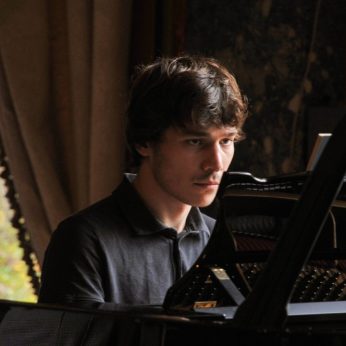Composer: Joseph Haydn (b. 1732 - d. 1809)
Performance date: 26/06/2023
Venue: Bantry House
Composition Year: 1794
Duration: 00:20:01
Recording Engineer: Tom Norton, RTÉ
Instrumentation: pf
Instrumentation Category:Solo
Artists:
Jérémie Moreau -
[piano]

Keyboard Sonata in E flat major Hob.XVI:52 [1794]
Allegro – Adagio – Finale: Presto
At 64, Joseph Haydn was the vigorous, well-respected master of the musical world when he embarked on a lucrative visit to London in 1794. Once there, surrounded by virtuosos and wealthy patrons, he returned to composing for the piano, something he hadn’t done for five years.
“I would sit down at the piano and begin to improvise, whether my spirits were sad or happy, serious or playful,” Haydn write. “Once I had captured an idea, I strove with all my might to develop and sustain it in conformity with the rules of art.”
Haydn was keenly aware that the sound of the English piano was very different from that of its Viennese counterpart. Viennese pianos were quick and responsive but their sound, like their action, was light. English pianos had a heavier action, longer keys, and a fuller, more room-filling sound.
The so-called ‘London’ piano school (Clementi, Cramer, Dussek) excelled in exploiting a richer sonority to create keyboard textures brimming with dramatic effects that played to the instrument’s dizzying runs plunging from the top to the bottom of the keyboard, and dulcet double thirds for an extra-sweet sonority in the upper register. Haydn chose to adopt the teachings of the London piano school, because his Sonata in E flat contains all of them, and more.
There is every reason to believe that this was Haydn’s final sonata more because of circumstance than intention. For Haydn, as it was for other composers of his generation, the solo keyboard sonata was either a tool for teaching, or a flattering gesture of gratitude to a generous patron. Had subsequent opportunities presented themselves, the series might well have continued. There was no want of creative energy, after all. And while this was Haydn’s last published sonata, it was by no means his last composition. He returned to Vienna in 1795. The final string quartets and the huge oratorios, The Creation and The Seasons, were yet to be written. He died at the age of 77.
Francis Humphrys
Copyright © 2025 West Cork Music. All rights reserved.
Designed and developed by Matrix Internet